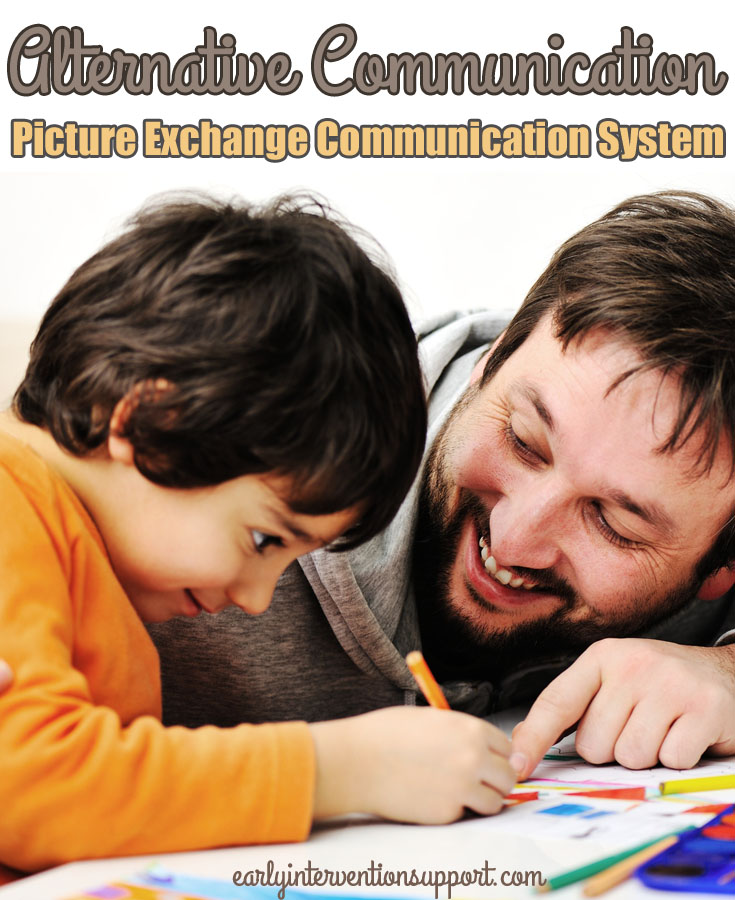Communication comes in many forms. From a cry to express hunger to rhythmic kicks of their feet to show excitement, children begin communicating in the earliest years of their life. For most, communication continues to develop and becomes an everyday effortless activity; however, for individuals with disabilities, communication can be a constant obstacle.
Early identification of developmental delays is essential to a child’s progress. If a child has a communication delay, a speech therapist will support the family in assisting their child in developing communication. There are five areas of communication: speech, gestures, sign language, pictures, and writing. All modalities have their advantages and disadvantages. When speech is challenging for a child, a speech therapist may look to alternative communication systems to build a foundation for functional communication.
Picture Exchange Communication System (PECS) is an alternative communication intervention. Developed in 1985 by Lori Frost and Andy Bondy, PECS was primarily implemented with preschool-aged children diagnosed with Autism Spectrum Disorder and other social-communicative disorders. Children with these diagnoses often avoid interactions, do not approach others to communicate, or respond only to a direct cue. PECS has since helped children with many disabilities to approach and initiate a request for a desired object from a communication partner.
Six Phases of PECS
The six phases of PECS parallel that of language development:
PHASE I
PECS first teaches a child “how” to communicate. Children learn how to make simple requests by giving a picture to a communication partner in return for the desired object. Children learn to initiate communication.
PHASE II
Children continue to use single pictures to make requests but in different settings. In this phase, children are taught to “generalize” or use their learned skills across different environments (home vs. school), different communication partners (parents vs. teacher), and longer distances (taking picture from bedroom to kitchen). Children learn to be persistent communicators.
PHASE III
Picture Discrimination: Children have learned to request a desired object with a single picture. In Phase 3, children are presented with two or more pictures of their favorite items. This teaches the child to discriminate between each picture and select their preferred choice. The child then removes the picture and follows through with giving the picture to a communication partner to receive the object/action in return.
PHASE IV
Sentence Structure: Children begin to combine single pictures to make a grammatical structure on a sentence strip. A child can start to expand on their single picture requests and build an “I want” phrase!
PHASE V
Answering Questions: Children are able to spontaneously request a variety of items and can answer the question “What do you want?” This is the first time that a child is prompted with a question to request.
PHASE VI
Commenting: Children are able to answer simple questions such as “What do you want?” “What do you see?” “What do you have?” and “What is it?” They continue to spontaneously request and learn to form a phrase to comment such as “I see” “I hear” and “It’s a”.
Misconceptions about PECS
One common misconception is that if you use pictures to communicate, you are using PECS. Pictures can supplement communication to help children build understanding, such a providing pictures for a child to understand what may be coming next (i.e. visual schedule). The PECS protocol must be followed in order for a picture exchange system to be classified as PECS.
Will PECS prevent my child from talking? Bondy & Frost (1994) found that PECS increases vocalizations and improves current speech skills. In addition, Schwartz, Garfinkle, and Bauer (1998) found a positive correlation between the use of PECS and speech development in preschool children with various communication deficits. Research (Romski & Sevick, 1996; Mirenda & Erickson, 2000) has shown that not only do augmentative communication systems not inhibit speech development but that use of these systems enhances the likelihood of the development or improvement of speech (Bondy & Frost, 2001).”
References
Bondy, A., & Frost, L. (1994). The Picture Exchange Communication System. Focus on Autistic Behavior.
Bondy, A.S., and L. Frost. 2001. “The Picture Exchange Communication System.” Behav Modif. 25(5):725-744.
Frost, L., & Bondy, A. (2002). The Picture Exchange Communication System training manual, 2nd ed. Pyramid Educational Consultants, Inc.
Romski, M. A., & Sevcik, R. A. (1996). Breaking the speech barrier: Language development through augmented means. Baltimore: Brookes.
Mirenda, P., & Erickson, K. (2000). Augmentative communication and literacy. In A. Wetherby & B. Prizant (Eds.), Autism spectrum disorders: A transactional developmental perspective (pp. 333–367). Baltimore: Paul H. Brookes
Schwartz, I.S., Garfinkle, A.N., Bauer, J. (Fal 1998) The Picture Exchange Communication System: Communicative outcomes for young children with disabilities. Topics in early Childhood Special Education, Vol 18(3).

